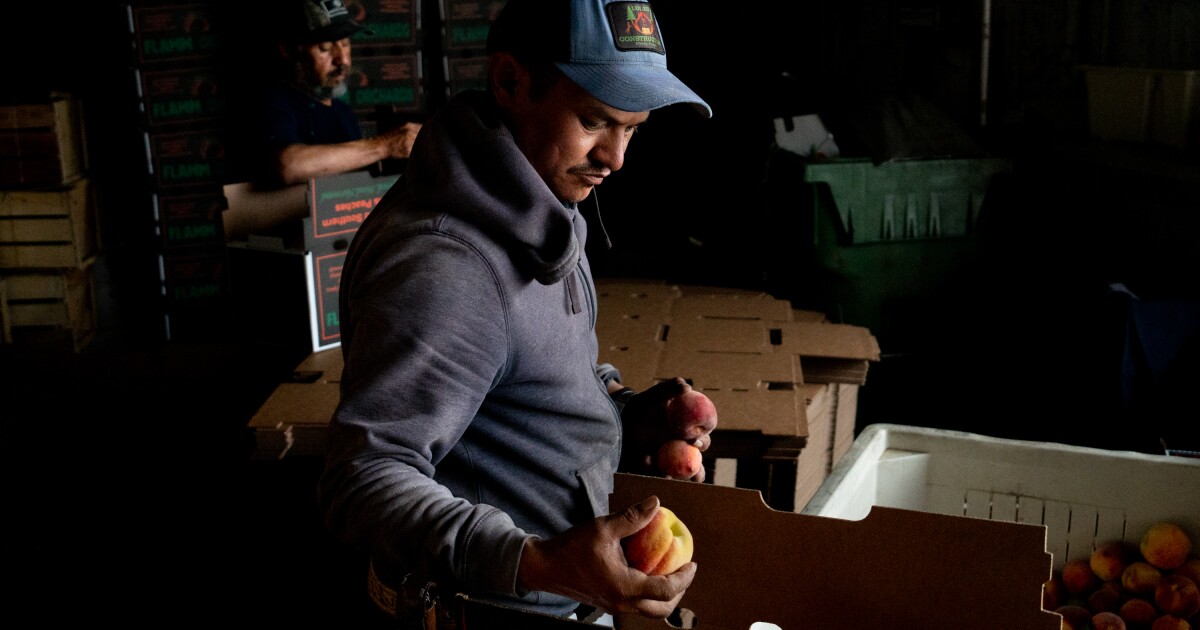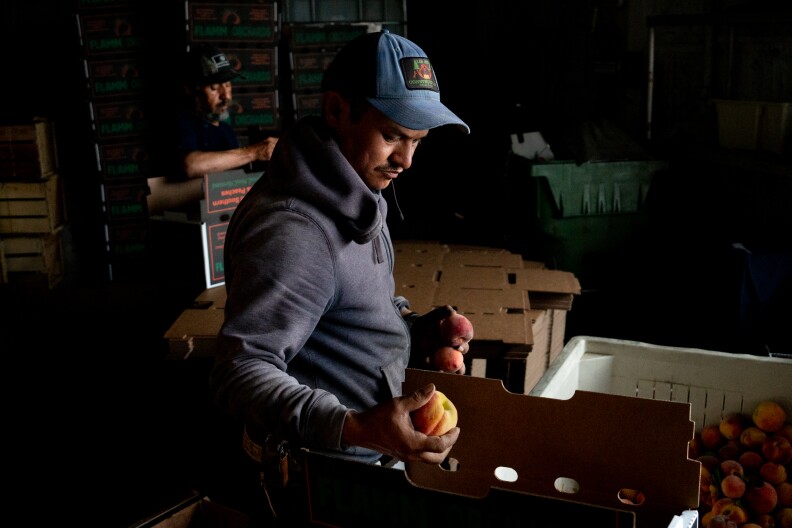Business
December weather leads to peach shortage in southern Illinois

[ad_1]

COBDEN, Ill. — Despite the chatter and hustle of a dozen or so workers, the production line at Flamm Orchards in deep southern Illinois sits mostly barren this summer because a cold spell in late December knocked out a vast majority of the 300 acre farm’s peach crop.“To have a loss as bad as we’ve had this year, it’s very rare,” said Austin Flamm, the farm manager of the family orchard. “This is the worst loss we’ve had in about 16 seasons.”With the help of seasonal workers, Flamm’s automated operation would wash, sort and package hundreds of thousands of peaches that are produced on the Union County orchard in a typical year.But 2023 isn’t a typical year. There are so few peaches that Flamm Orchards is processing their fruit by hand and selling very little wholesale to grocery stores.“It’s a very bad crop this year,” Flamm said.For many people, summer is synonymous with peaches, but they will be harder to come by. Consumers will still see the fuzzy fruits on grocery store shelves this summer, but there may not be as many local varieties, and they may be pricier.In the Metro East, Chris Eckert, president of Eckert’s Inc., said it’s hard to guesstimate just exactly how much his 300 acre orchard lost during the same storm. While he won’t know exact figures until the season’s over, and he’s done all his math, it’s pretty easy to tell that it’s not a good year.“We’re going to be pretty excited about a half a crop — if we can get that,” he said.Southern Illinois peach producers are not alone, as warm weather in Georgia knocked out 90% of the Peach State’s production earlier this spring.
Brian Munoz
/
St. Louis Public RadioSunlight falls on a bin of peaches waiting to be packaged on July 13 at Flamm Orchards.
The national pictureWhile Georgia is known as the “Peach State,” California tops production — and it’s not close. South Carolina, generally, produces a little more than Georgia too.Kay Rentzel, the executive director of the National Peach Council, said South Carolina also had a rough year. She estimates South Carolina’s production will stand between 30-40% of normal figures.“With such a significant number and volume of fresh peaches coming out of Georgia and South Carolina in any typical year, it does make a big difference to the marketplace and the availability of fresh peaches,” Rentzel said.Lucky for peach connoisseurs, California’s crop should be better. The Mid Atlantic region also had a solid year, she said.
Brian Munoz
/
St. Louis Public RadioAcres of peach trees line the land on July 13 at Flamm Orchards in Cobden, Ill.
Exactly how much Illinois plays into the national picture is hard to determine. With only three commercial orchards — Flamm’s, Eckert’s and another Union County — the U.S. Department of Agriculture doesn’t keep detailed records of the state’s production.However, because there’s a drop in the local supply and on the national scale, the price of peaches will trickle upward this season, Rentzel said.Formerly the president of the National Peach Council, Eckert said he expects peach prices will be up 25-50% nationally. At this Belleville store, he estimates his prices are closer to 20% higher this year. Flamm guesses his are up 30%.
Will Bauer
/
St. Louis Public RadioChris Eckert, president of Eckert’s Inc., assesses some of his peaches on July 12 at the orchard in Belleville.
Weather can be tricky for farmersEvery decade or so, peach farmers expect a bad year. For Eckert, his last was 2014. But this year’s shortage brought something he’d never seen before.The frigid December temperature knocked out nearly all of the trees that grow the GaLa variety of peaches. But just a few rows over, the Red Haven variety remained unscathed. On one side of the hills that cut through his orchard, some varieties did well. And on the other side, there’s none.It’s a strange outcome that he, his peers and other experts from the industry haven’t been able to diagnose. But then again, farmers expert nature to produce curious outcomes, he said.“These types of one-off situations are not that unusual,” he said. “In our world, it’s like, ‘Well, that’s never happened before.’”Why Belleville’s peaches fared better than Cobden’s peaches two hours south also feels random — almost a mystery — to the producers.
Brian Munoz
/
St. Louis Public RadioJuan Antonio Vicente Lopez, 31, secures bushels of peaches on July 13 at Flamm Orchards in Cobden, Ill.
Eckert said he didn’t realize how bad it was until Austin Flamm’s uncle, Mike, called him in the spring. Until then, he didn’t expect this bad of losses.“Goes to show: You never can be too arrogant in this business because Mother Nature is always going to treat you to some humble pie,” Eckert said.For the peach producers, losing some crops is anticipated. It’s what farmers call “partial loss.” But a “total loss” might have been more convenient for Flamm. If they’d lost all their peaches, they wouldn’t have to pay for labor, chemicals and other costs this season.“We’d have been better off without any, but it is what it is,” Flamm said. “You got to play with the hand you’re dealt.”This year’s crop shows the danger of agriculture and just how much the weather’s volatile nature can be the industry’s biggest detriment, said Raghela Scavuzzo, the executive director of the Illinois Specialty Growers Association.“Look at an agritourism business that might be open eight weeks to 10 weeks out of the year,” she said. “If it rains every weekend, nobody’s gonna be there on the farm.”
Brian Munoz
/
St. Louis Public RadioCustomers shop for sweet peaches on July 13 at Flamm Orchards in Cobden, Ill.
What does the shortage mean for the farms?For both orchards, peaches are the biggest money makers. In Belleville, it’s a multimillion dollar crop, and that means a multimillion dollar impact on their revenue, Eckert said.Despite the meager peach year, it’s not all gloom and doom. Both Eckerts and Flamm said USDA-backed insurance can help them get through bad years like this. Also, they produce other fruits and veggies.“The nice thing about most of our specialty crop production is that they are diversified, which means that peaches are not their own business revenue,” Scavuzzo said.Both Eckert and Flamm say they’re expecting solid apple, blackberry and strawberry crops.“It helps offset from the lack thereof on the peaches,” Flamm said.There’s another silver lining too. Because Illinois producers aren’t selling as many peaches wholesale to grocery stores, this may be a good year for an excuse for customers to go directly to their local orchard, Scavuzzo said.“We know Georgia gets credit for their peaches, but our peach producers are phenomenal,” she said.
Brian Munoz
/
St. Louis Public RadioTerry Briscoe, of Channahon, Ill., Rachel Cullin and her 6-year-old daughter Katrina, both of Coal City in central Illinois, walk to their vehicles after purchasing sweet peaches on July 13 at Flamm Orchards in Cobden, Ill.
For Eckert, the seventh generation in his family to run the orchard, local peaches are just better. As soon as they’re picked from the tree, the peach is a time bomb. The longer it takes for the fruit to find its way to a consumer, the worse it gets, he said.That’s different from an apple, which stays ripe a little longer while it’s being shipped or sitting on a shelf.Regardless, Eckert said it resonates with customers when they don’t have a fresh, juicy peach.Lucky for the Illinois producers, the higher prices this season aren’t keeping away customers like Dan Elkins away. The self-prescribed “Flamm Fan” — and former 15-year-old peach picker — drove the hour from Cape Girardeau for the fresh fruit in mid July.He said he’d normally buy two bushels. On this Thursday afternoon, he said he’d settle for one.“This is a great operation,” Elkins said. “They’ve got great people here. Love the peaches, so I’ll be back for more.”
[ad_2]
Source link
Business
Laclede’s Landing is moving from nightlife hub to neighborhood

[ad_1]

Laclede’s Landing has cycled through many identities throughout the history of St. Louis. Now, some people involved with its redevelopment in recent years hope the landing’s next one will be as a residential neighborhood.The small district tucked directly north of the Gateway Arch National Park has quietly undergone a massive redevelopment with more than $75 million pouring into the rehabilitation of many of the historic buildings at the landing.“We are starting to feel that momentum, especially in the last really 60 days. Things have drastically changed around here,” said Ryan Koppy, broker and owner of Trading Post Properties and the director of commercial property for Advantes Group.Advantes alone shouldered the rehabilitation of six of the historic buildings, which now sport a mix of apartments and retail or office space, he said. Four of those buildings are completed, and of the 119 apartments available, about 90% are filled, Koppy said.“It just shows you what kind of demand we do have for the area,” he said. “We’re separated from downtown a little bit, and for the tenants, their local park where they’re walking their dogs, it’s a national park.”
Sophie Proe
/
St. Louis Public RadioInterior of the Peper Lofts at Laclede’s Landing on Aug. 16
Another 40 apartments are set to come online next year along with some retail space, Koppy said. He added he’s noticed a wide range of people who are considering and moving into the newly refinished apartments.“It’s very mixed, surprisingly,” Koppy said. “We have a lot of young professionals, maybe on their second job out of [university], we have some empty nesters too.”Part of the newfound momentum comes from a new market, the Cobblestone, and coffee shop, Brew Tulum, opening recently and bringing more foot traffic to the area, said Brandyn Jones, executive director of the Laclede Landing Neighborhood Association. She added that more apartments are set to come online within the next few months.“We have a great riverfront area here and so there are plans in the works to activate those spaces, bring people in,” she said.That could be more daytime events, like a farmers market, music festivals (one of which is happening this weekend) or just bringing in food trucks to Katherine Ward Burg Garden, Jones said. It’s a departure from the identity the district held a few decades ago as a hub for nightlife and entertainment.“That’s part of what connects so many people to Laclede’s Landing,” Jones said. “It’s important to tell the story of where we’re evolving. It won’t be what it was in the same exact way, but it will still be fun, and it can be fun early morning, midday or late night.”It’s a view shared by Koppy.“It’s grown up, it’s a bit mature,” he said. “We’re not going to have 3 a.m. bars here anymore because we have residents here.”Koppy added that Advantes is joined by other developers working to rehabilitate buildings in the district.“We all work in unison,” he said. “If I get a call and [a client is] asking for something and maybe the square foot doesn’t really match up with what I have available, but I know it matches up over there, they’re getting a very warm welcome and introduction.”
Sophie Proe
/
St. Louis Public RadioRyan Koppy looks out the window of Brew Tulum Specialty Coffee Experience on Aug. 16 at the Cobblestone on Laclede’s Landing in downtown St. Louis.
This push toward making Laclede’s Landing a residential neighborhood also comes alongside broader conversations about the future of downtown St. Louis more generally as it looks to move away from a dependence on office space. While the city as a whole continues to lose population, downtown added about 1,700 people between 2010 and 2020, according to U.S. Census data.“It’s been wonderful timing to have all that going on, that stress that you’re not just in downtown to work has been critical to part of this rejuvenation and energy down here,” Jones said. “Sometimes people forget Laclede’s Landing is part of downtown, really the original downtown.”And success in the small district could spread beyond its small confines and potentially serve as a model for success, Koppy added.“My idea is, if we could get all the great things of St. Louis coming in through here, we can eventually spread that,” he said. “We understand we can’t change the whole world, but we’ll just make the effort to try and change the world around us.”
[ad_2]
Source link
Business
St. Louis barbecue festival Q in the Lou canceled

[ad_1]

The largest barbecue competition and tasting festival in St. Louis, Q in the Lou, has been canceled. The event was planned for Sept. 6-8, but organizers decided to cancel it due to poor ticket sales and insufficient corporate sponsorship.The traveling festival had low attendance in Denver last week, said Sean Hadley, a festival organizer.“We made the tough decision to cancel Q in the Lou,” said Hadley. “We’re seeing a lack of support … it’s just not there.”The traveling event first came to St. Louis in 2015 and drew hundreds of people to downtown St. Louis for barbecue, live music and a “major party.”“It shut down out of the blue … I’ve gone every year,” said Scott Thomas, local chef and food blogger. “It’s brilliant. You could take a tour of some really amazing barbecue restaurants and competition barbecue guys all in one place.”In a late July news conference, city officials touted Q in the Lou as a significant tourism draw and a boost for downtown revitalization.“Bringing a signature national festival back to downtown St. Louis … is making us stronger,” Greater St. Louis Inc. CEO Jason Hall said then.Less than a month later, ticket holders from every festival stop learned they’d be refunded. On Monday, organizers privatized the Q in the Lou website and deleted its social media accounts.Conner Kerrigan, a spokesperson for Mayor Tishaura Jones’ office, said city officials are disappointed the festival won’t be back this year.“St. Louis knows how to throw a festival … bringing people together to celebrate our culture is one of the things we do best as a city,” Kerrigan said in a statement. “Should Q in the Lou try to come back next year or any year after that, they’ll have the support of the Mayor Jones administration.”
[ad_2]
Source link
Business
Alton’s Jacoby Arts Center likely to relocate permanently

[ad_1]

The Jacoby Arts Center, a staple of Alton for many in the Metro East community, will likely permanently move out of its downtown building at the end of September.Its departure and relocation from the historic building that the arts center has called home for the past 20 years has created a tense situation for not only the arts center’s supporters but also the local development company working to revitalize Alton’s downtown that owns the building.“It’s an unfortunate situation,” said Chad Brigham, the chief legal and administrative officer with AltonWorks, the real estate company owned by another prominent local attorney working to develop the town. “I wish there wasn’t misunderstanding and disappointment in the community. It’s difficult sometimes to clarify that.”When news of the likely departure spread in June via a letter from the Jacoby Arts Center to its supporters, an outcry on social media quickly followed. Some assumed it would be the end of the arts center.“There’s a lot of feelings right now that I think are more about the building itself than there are about the Jacoby Arts Center,” said Valerie Hoven, vice president and treasurer of the nonprofit arts center’s board.For supporters of the Jacoby, moving from the building and likely never returning will be a sad affair. Exactly what’s next for the arts center remains unclear. However, Jacoby board members believe this will not be the end of the organization. It will likely look different though.
Sophie Proe
/
St. Louis Public RadioThe Jacoby Arts Center earlier this month in downtown Alton
Sophie Proe
/
St. Louis Public RadioThe Alton-based Jacoby Arts Center features more than 75 St. Louis-area artists and their work.
The history of the buildingFirst dubbed the Madison County Arts Council, the nonprofit arts center renamed itself after the Jacoby family gave it the current building in 2004. AltonWorks founder John Simmons purchased the Jacoby Building in September 2018, according to property records from the county.Managing the large building, at 627 E. Broadway, became too expensive for the Jacoby Arts Center. In 2018, the organization approached Simmons to purchase it, said Dennis Scarborough, a past president of the board and a downtown business owner.“Of course, it sounded really, really good,” Scarborough said of Simmons’ purchase. “He took over the insurance, property taxes, all those kinds of things that were really, really getting into our budget, and he rented it to us at a fair price.”The two parties entered into a lease agreement initially for five years. Since then, Simmons has spent more than $1 million in upkeep, taxes, insurance and more on the building. The lease has been extended twice until the end of September this year.Over the six years, Jacoby paid $1,500 per month, which covered a portion of the utilities.“It’s been wonderfully generous of AltonWorks,” Hoven said.Because the building is aging and needs repairs, Brigham with AltonWorks and those connected to the arts center have long known the Jacoby Arts Center would need to relocate — at least temporarily.
Renovations on the Jacoby building will begin this fall. They’ll include modernizing the aging building, repairing the old elevator and putting in apartments on the second and third floors.
News of the likely departure and controversyRenovations will begin this fall. They’ll include modernizing the aging building, repairing the old elevator and putting in apartments on the second and third floors.In May, it became clear that a preliminary proposal for the arts center to return to the building after renovations finished in 2026 would not work for them, Hoven said.She estimates the first floor and basement of the Jacoby Arts Building span roughly 20,000 square feet.
Chad Brigham is a business and legal adviser for AltonWorks.
AltonWorks’ initial idea floated to the arts center would only provide 2,553 square feet, according to both Hoven and Brigham. While the board calculated the price for the new space to be at least triple the current payment, Brigham said there was never a specific price discussed.“No discussion in terms of actual rent price,” he said.AltonWorks didn’t make a specific rent offer because the organization doesn’t even know itself, Brigham said.In addition to cash from John Simmons, there will be loans, tax increment financing and state tax credits to cover the $20 million in building renovations. The entities financing the cost of renovations will also help determine the rent when the construction is complete, Brigham said.Regardless, the price required to return will be too much for the arts center to pay, Hoven said. Also, the organization would like to maintain the many programs it offers to the community — a rentable event space, a dark room and a clay studio, for example — in the future.“For us to really meet the needs of the community and be sustainable, we need a space where we can offer some of those programs — the artists’ shop, and other spaces that offer some kind of income as well — so that we can continue to give money back to the community,” she said.AltonWorks offered at least two other locations as possible alternatives from their vast stock of buildings along Broadway to house the arts center during the roughly 18 months of construction. Those alternatives came with similar deals requiring the Jacoby to cover only utilities, Brigham said.“We did put in a great deal of work behind the scenes in trying to find an interim solution,” Brigham said. “We wanted to find a place for them to go, where it was easy for them to continue programming, whether it’s 100% of it or some portion of it, that would work for them.”Initially, the arts center hoped to keep the basement during the renovations, Hoven said. When it became clear the preliminary offer to return was for much less space than the arts center anticipated, the letter to the community was sent.“The letter that came out was merely showing our surprise,” Hoven said. “Don’t misinterpret it as panic. Don’t misinterpret it as desperation.”
Sophie Proe
/
St. Louis Public RadioA smorgasbord of radios are displayed at the Jacoby Arts Center in Alton.
The commentary on social media was passionate. Some critics of AltonWorks said the organization has good intentions but hasn’t executed those plans. Others said Jacoby hasn’t planned well enough for the future.For Brigham and the AltonWorks team, some of the criticism has been disappointing.“I thought that there were some decent solutions. Were they perfect? No, but they were very, I thought, very good solutions,” he said. “And the fact that it has come to the point that it is right now is a bit hurtful.”AltonWorks remains committed to the arts, Brigham said. John Simmons remains one the largest donors of the Jacoby Arts Center, Hoven and Brigham said.“I don’t think there’s ever been a question of our support of that organization — of our affinity for that organization,” Brigham said. “While some of the events were unfortunate, some of them were encouraging. The entire community rallied around the Jacoby Arts Center. That’s a good thing. It’s a good thing to have a love for the arts like that in a downtown community.”Sara McGibany, the executive director of Alton Main Street, an organization aimed at preserving the town, said AltonWorks should be commended for its vision. In many ways, her organization and AltonWorks share a vision for a thriving downtown.Even though AltonWorks hosts public meetings, McGibany believes the current situation lacks true community engagement.“We really think that if AltonWorks can get past some of the communication hurdles — and harness the community’s passion and shift to more of a bottom-up decision-making process that centers on community input — then we can turn around the growing sentiment of distrust that’s happening now,” McGibany said.Scarborough, the past board president and downtown business owner, echoed the praise for Simmons and his support of the Jacoby Arts Center. With the Jacoby likely moving, the future looks bleak, though.“It’s a community arts center that does a lot of good work,” Scarborough said. “The community is going to suffer, and they’re going to be missed by the community if they’re not there.”
Eric Lee
/
St. Louis Public RadioShalanda Young, director of the federal Office of Management and Budget, talks to Illinois U.S. Rep. Nikki Budzinski, D-Springfield, during a tour of a construction project by AltonWorks last April in Alton. AltonWorks, who is building the LoveJoy Apartment Complex is receiving over $1 million in federal funding.
What does the future hold?AltonWorks will continue forging ahead with its ambitious plans to revitalize Alton. The organization hopes to conclude construction on the Wedge Innovation Center, which will have a restaurant, retail and co-working space, this fall. Lucas Row, a mix of apartments and retail space, is scheduled to be completed next spring.The remainder of the arts and innovation district, currently named after the Jacoby, will also move forward.“I believe in two years it’s going to be a much different place,” Brigham said of Alton. “It’s going to be thriving. It’s going to be new businesses, new tenants — and it’s going to be a nice proof of concept for what you can do in a small community like that.”The Jacoby board recently formed a strategic planning committee. Its task: figuring out what’s next for the arts center. The committee will reevaluate what space the Jacoby needs, what programs it wants to offer to the community and how they want to make that a reality.Keeping the arts center is essential for board members like Hoven. In her experience, it’s been a place where local aspiring artists get their start.“Art is one of the only ways to show your true authentic self,” Hoven said. “And there’s more people than I realized who do not get that opportunity every day.”The Jacoby will shut its doors to pack over the next month. Hoven said she’s optimistic the board will have concrete plans by the end of September when their lease officially ends.“Alton is such a fabulous and supportive community,” she said. “We still have lots of great options, so that the Jacoby Arts Center will continue to thrive in Alton and beyond.”
[ad_2]
Source link
-

 Politics2 years ago
Politics2 years agoPrenzler ‘reconsidered’ campaign donors, accepts vendor funds
-
Board Bills1 year ago
2024-2025 Board Bill 80 — Prohibiting Street Takeovers
-

 Board Bills3 years ago
Board Bills3 years ago2022-2023 Board Bill 168 — City’s Capital Fund
-

 Business3 years ago
Business3 years agoFields Foods to open new grocery in Pagedale in March
-

 Business3 years ago
Business3 years agoWe Live Here Auténtico! | The Hispanic Chamber | Community and Connection Central
-

 Entertainment2 years ago
Entertainment2 years agoOK, That New Cardinals/Nelly City Connect Collab Is Kind of Great
-

 Entertainment3 years ago
Entertainment3 years agoSt.Louis Man Sounds Just Like Whitley Hewsten, Plans on Performing At The Shayfitz Arena.
-

 Local News2 years ago
Local News2 years agoFox 2 Reporter Tim Ezell Reveals He Has Parkinson’s Disease | St. Louis Metro News | St. Louis





